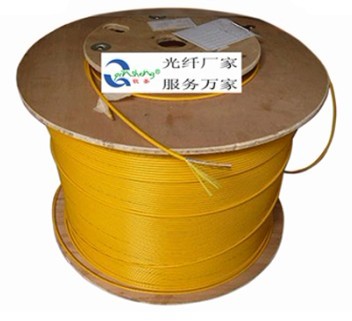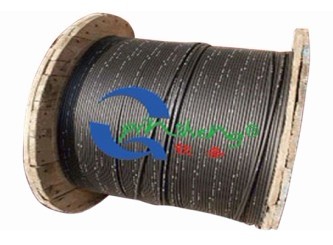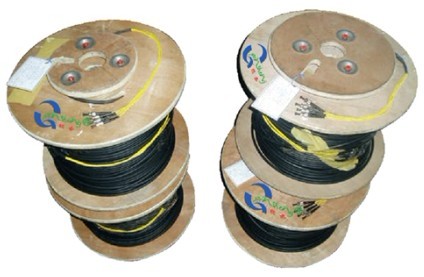Fiber and Fiber Routing <br><br><br><br><br><br><br><br><br><br><br><br><br><br><br><br><br><br><br><br><br><br><br><br><br><br><br><br><br><br><br><br><br><br><br><br><br><br><br><br><br><br><br It is transparent and slender. Although it is thinner than hair, it has a waveguide structure that encloses light and propagates in the axial direction. Optical fiber communication is developed because of this magical structure of optical fiber. Lightwave is the carrier frequency, and optical fiber is a communication method of transmission media.
At present, the wavelength range of light waves used in optical communication is in the near-infrared region, and the wavelength is 0.8 to 1.8 um. Can be divided into short wavelength segments (0.85um) and long wavelength segments (1.31um and 1.55um). Because optical fiber communication has a series of excellent characteristics, the development speed of optical fiber communication technology is extremely rapid in recent years. It can be said that this emerging technology is an important symbol of the world's new technology revolution, and it is also a major transmission tool for various information networks in the future information society. In summary, optical fiber communication has the following advantages:
Transmission frequency bandwidth, large communication capacity The optical fiber network is known by information theory. The higher the carrier frequency, the greater the communication capacity. The frequency of light waves currently used is 1000 to 10000 times higher than the frequency of microwaves, and the communication capacity can be increased by about 1,000 to 10,000 times.
Low-loss optical fiber networks are currently used in optical fiber homo-quartz series fiber, and because the purity of the resulting quartz glass media is extremely high, the loss of the optical fiber is extremely low and the relay distance can be very long. In this way, the number of relay stations can be reduced in the communication line, the cost can be reduced, and the communication quality can be improved.

Immunity to electromagnetic interference fiber networks Because optical fibers are non-metallic media materials, they are inherently immune to electromagnetic interference. This is beyond the reach of Other cables.
Fine-diameter light fiber network,
Because the diameter of the optical fiber is only about 0.1mm, the optical fiber product is thinner than the metal cable and the weight is light. This facilitates the manufacture of a multi-fiber cable and improves the space utilization rate of the cable.
Resource-rich optical network,
The main component of the optical fiber is quartz, so the material resources for manufacturing the optical fiber are abundant, and the manufacturing cost is also low. With this unique advantage alone, it has made it more popular.
It is because of the above advantages of optical fibers that broadband optical fibers have gradually replaced narrow-band metal cables since the 1980s.
However, things can not be 100% perfect, and optical fibers have their own drawbacks, such as the relatively brittle texture and low mechanical strength is its fatal weakness. Little attention will be broken in the cable jacket. Construction workers should have better cutting, connection, shunting, and coupling technologies. However, with the continuous development of technology, these problems can be overcome.
In the structured cabling system, the optical fiber not only supports the FDDI backbone, 1000Base-FX trunk, 100Base-FX to the desktop, ATM trunk ATM to the desktop, but also supports CATV/CCTV and fiber to the desktop (FTTD), so it is common with copper cables. Become the protagonist of structured cabling.
Today, there are two main internationally-available cabling standards, one is the North American standard EIA/TIA-568A, and the other is the international standard ISO/IEC IS11801. EIA/TIA-568A and ISO/IEC IS 11801 recommend the use of 62.5/125um multimode fiber optic cable, 50/125um multimode fiber optic cable, and 8.3/125um multimode fiber optic cable.
Single mode fiber and multimode fiber can be easily distinguished from the size of the core.
The core of single-mode fiber is very small, about 4-10um, transmitting only the main mode. This completely avoids modal dispersion, makes the transmission band very wide, and has a large transmission capacity. This fiber is suitable for large-capacity, long-distance fiber optic communications. It is an inevitable trend in the future development of optical fiber communications and lightwave technology.
Multimode fiber is further divided into multimode mutant fiber and multimode gradient fiber. The former has a larger core diameter and more transmission modality, so the bandwidth is narrower and the transmission capacity is smaller. In the latter core, the refractive index decreases as the radius increases, and a smaller modal dispersion can be obtained, resulting in a higher frequency band. Wide, large transmission capacity. Generally we use the latter.

Optical fiber network commonly used multi-mode and single-mode fiber core and skin size:
Multimode fiber (core/skin):
*50/125um
*62.5/125um
Single mode fiber (core/skin):
*8.3/125um
800nm-900nm short wave band 1250nm-1350nm long wave band 1500nm-1600nm long wave band In these bands, the optical fiber transmission performance is the best, especially in the center wavelength of the band. Therefore, the operating wavelength of the multi-mode light is 850 nm or 1300 nm, and the operating wavelength of the single-mode fiber is 1310 nm or 1550 nm.
However, no matter how good the optical fiber transmission performance is, it still encounters the biggest problem shared by the communication system—the attenuation of the signal. In fiber optic wiring, the cause of attenuation is inherently external. Intrinsic attenuation is related to fiber optic material, and external attenuation is related to construction installation. The reduction in intrinsic attenuation depends on the cable manufacturer. They will work on improvements in materials and processes. The external attenuation is generally caused by variations in fiber laying, coupling losses of the fiber and light source, and loss of connection between the fibers. These can be reduced through the efforts of construction workers. Therefore, construction workers should pay attention to:
1) Do not exceed the minimum bend radius when bending the cable.
2) The traction force for laying optical cables should not exceed the maximum laying tension. At the same time, external forces (lateral pressure, impact, bending, twisting, etc.) that cause the fiber to undergo transitions should be avoided.
3) Terminated and maintained optical fiber should be performed by trained technicians.
When optical cables are used in trunks, at least 6 core cables are used in each floor wiring room, and 12 core cables are better for advanced applications. This is considered from the three aspects of application, backup, and capacity expansion. As for the optical fiber networking, it is also very flexible. Can be achieved: (1) point to point. Establish a high-speed channel between the two computers. The transmission rate is several Mbps to several hundred Mbps, and the distance is up to 2 kilometers, (multimode) to 5 kilometers (single mode). (2) Star network. Through the optical network equipment, a star network topology is established. (3) Ring network. The signal regenerators are connected by optical fibers to form a loop.
With the development of science and technology, higher and newer requirements have been put forward for optical fibers. The old wiring standards have been tested in practice and are now being revised. In addition to the revision of the original specification, some new requirements will be added. It is believed that optical fiber will play a more important role in it. It is also not difficult to predict the bright future of optical fiber communications and fiber optic cabling.

At present, the wavelength range of light waves used in optical communication is in the near-infrared region, and the wavelength is 0.8 to 1.8 um. Can be divided into short wavelength segments (0.85um) and long wavelength segments (1.31um and 1.55um). Because optical fiber communication has a series of excellent characteristics, the development speed of optical fiber communication technology is extremely rapid in recent years. It can be said that this emerging technology is an important symbol of the world's new technology revolution, and it is also a major transmission tool for various information networks in the future information society. In summary, optical fiber communication has the following advantages:
Transmission frequency bandwidth, large communication capacity The optical fiber network is known by information theory. The higher the carrier frequency, the greater the communication capacity. The frequency of light waves currently used is 1000 to 10000 times higher than the frequency of microwaves, and the communication capacity can be increased by about 1,000 to 10,000 times.
Low-loss optical fiber networks are currently used in optical fiber homo-quartz series fiber, and because the purity of the resulting quartz glass media is extremely high, the loss of the optical fiber is extremely low and the relay distance can be very long. In this way, the number of relay stations can be reduced in the communication line, the cost can be reduced, and the communication quality can be improved.

Immunity to electromagnetic interference fiber networks Because optical fibers are non-metallic media materials, they are inherently immune to electromagnetic interference. This is beyond the reach of Other cables.
Fine-diameter light fiber network,
Because the diameter of the optical fiber is only about 0.1mm, the optical fiber product is thinner than the metal cable and the weight is light. This facilitates the manufacture of a multi-fiber cable and improves the space utilization rate of the cable.
Resource-rich optical network,
The main component of the optical fiber is quartz, so the material resources for manufacturing the optical fiber are abundant, and the manufacturing cost is also low. With this unique advantage alone, it has made it more popular.
It is because of the above advantages of optical fibers that broadband optical fibers have gradually replaced narrow-band metal cables since the 1980s.
However, things can not be 100% perfect, and optical fibers have their own drawbacks, such as the relatively brittle texture and low mechanical strength is its fatal weakness. Little attention will be broken in the cable jacket. Construction workers should have better cutting, connection, shunting, and coupling technologies. However, with the continuous development of technology, these problems can be overcome.
In the structured cabling system, the optical fiber not only supports the FDDI backbone, 1000Base-FX trunk, 100Base-FX to the desktop, ATM trunk ATM to the desktop, but also supports CATV/CCTV and fiber to the desktop (FTTD), so it is common with copper cables. Become the protagonist of structured cabling.
Today, there are two main internationally-available cabling standards, one is the North American standard EIA/TIA-568A, and the other is the international standard ISO/IEC IS11801. EIA/TIA-568A and ISO/IEC IS 11801 recommend the use of 62.5/125um multimode fiber optic cable, 50/125um multimode fiber optic cable, and 8.3/125um multimode fiber optic cable.
Single mode fiber and multimode fiber can be easily distinguished from the size of the core.
The core of single-mode fiber is very small, about 4-10um, transmitting only the main mode. This completely avoids modal dispersion, makes the transmission band very wide, and has a large transmission capacity. This fiber is suitable for large-capacity, long-distance fiber optic communications. It is an inevitable trend in the future development of optical fiber communications and lightwave technology.
Multimode fiber is further divided into multimode mutant fiber and multimode gradient fiber. The former has a larger core diameter and more transmission modality, so the bandwidth is narrower and the transmission capacity is smaller. In the latter core, the refractive index decreases as the radius increases, and a smaller modal dispersion can be obtained, resulting in a higher frequency band. Wide, large transmission capacity. Generally we use the latter.

Optical fiber network commonly used multi-mode and single-mode fiber core and skin size:
Multimode fiber (core/skin):
*50/125um
*62.5/125um
Single mode fiber (core/skin):
*8.3/125um
800nm-900nm short wave band 1250nm-1350nm long wave band 1500nm-1600nm long wave band In these bands, the optical fiber transmission performance is the best, especially in the center wavelength of the band. Therefore, the operating wavelength of the multi-mode light is 850 nm or 1300 nm, and the operating wavelength of the single-mode fiber is 1310 nm or 1550 nm.
However, no matter how good the optical fiber transmission performance is, it still encounters the biggest problem shared by the communication system—the attenuation of the signal. In fiber optic wiring, the cause of attenuation is inherently external. Intrinsic attenuation is related to fiber optic material, and external attenuation is related to construction installation. The reduction in intrinsic attenuation depends on the cable manufacturer. They will work on improvements in materials and processes. The external attenuation is generally caused by variations in fiber laying, coupling losses of the fiber and light source, and loss of connection between the fibers. These can be reduced through the efforts of construction workers. Therefore, construction workers should pay attention to:
1) Do not exceed the minimum bend radius when bending the cable.
2) The traction force for laying optical cables should not exceed the maximum laying tension. At the same time, external forces (lateral pressure, impact, bending, twisting, etc.) that cause the fiber to undergo transitions should be avoided.
3) Terminated and maintained optical fiber should be performed by trained technicians.
When optical cables are used in trunks, at least 6 core cables are used in each floor wiring room, and 12 core cables are better for advanced applications. This is considered from the three aspects of application, backup, and capacity expansion. As for the optical fiber networking, it is also very flexible. Can be achieved: (1) point to point. Establish a high-speed channel between the two computers. The transmission rate is several Mbps to several hundred Mbps, and the distance is up to 2 kilometers, (multimode) to 5 kilometers (single mode). (2) Star network. Through the optical network equipment, a star network topology is established. (3) Ring network. The signal regenerators are connected by optical fibers to form a loop.
With the development of science and technology, higher and newer requirements have been put forward for optical fibers. The old wiring standards have been tested in practice and are now being revised. In addition to the revision of the original specification, some new requirements will be added. It is believed that optical fiber will play a more important role in it. It is also not difficult to predict the bright future of optical fiber communications and fiber optic cabling.

Ningbo Kyson Cool Electronic Technology Co., Ltd. , https://www.kysoncool.com
